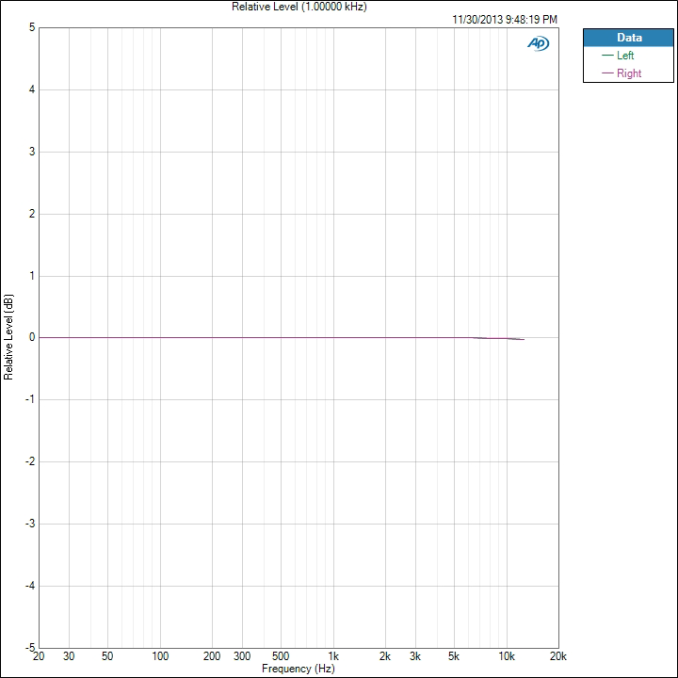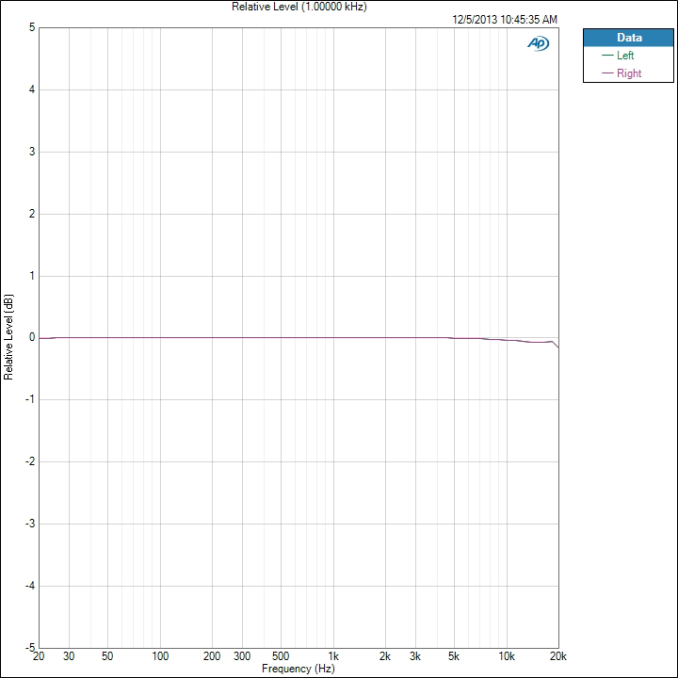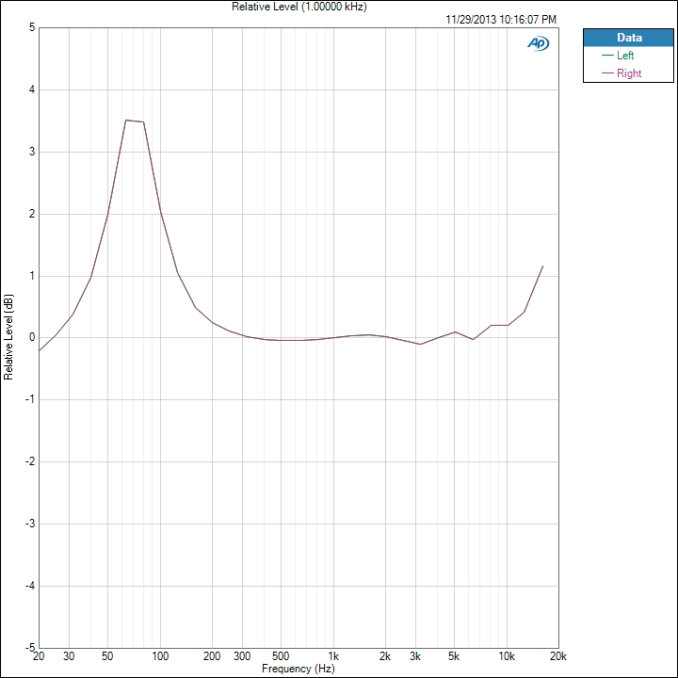Smartphone Audio Quality Testing
by Chris Heinonen on December 8, 2013 5:15 PM EST- Posted in
- Smartphones
- Audio
- Mobile
- Tablets
- Testing
Maximum Level
The maximum output level is derived from the 1kHz test tone used to determine THD+N. The higher the output from the headphone jack, the louder it can drive a pair of headphones. More importantly, having more power available means when you have dynamic music passages that call for power you are less likely to clip the waveform.
There is no chart to show here, just a number that the Audio Precision gives us. In our test data, the most powerful phone was the iPhone 5, at 32.46 mW of power. Next is the Nexus 5 at 22.24 mW, though we can’t drive it that high. Then the Note 3 at 11.81 mW and finally the Galaxy S4 at 3.895 mW. Doubling the power, from 4 mW to 8 mW, produces a 3 dB increase in volume level. 3 dB is the smallest change in volume levels we can easily hear. So even though the iPhone 5 produces 32 mW vs. 4 mW, that is only a 9 dB difference in volume. 10 dB is doubling the volume, so it isn’t even twice as loud. If you have demanding headphones, you will want as much power as you can get.
Frequency Response
To measure the frequency response we measure a set of 61 tones from 20 Hz to 20 kHz. All of these are then equalized to 1 kHz so we can see the maximum deviation from that level. An ideal phone will be perfectly flat here and allow you to adjust this with an EQ setting, or though your taste in headphones. On this test our best performing phone is the Galaxy S4, as seen here.
The total variation from 1 kHz is only 0.014 dB which is very good. The worst performing phone is the iPhone 5, but its variation is only 0.089 dB.
The iPhone 5 also picked up the 20 kHz tone while the Samsung and many others missed it. If we dropped this tone then it might be just as flat. The iPhone 5 test was run slightly differently, as it can't run the Android test program, which might account for this. For a phone with a different response, here is the HTC One with Beats enabled. Other HTC One testing is still in progress as I write this article.
Here we see that Beats is adding a +3.5 dB boost from 60 Hz to 90 Hz, but the deviation from 0 dB goes from 30Hz to 300 Hz. Past 6.5 kHz we also see a rise in the treble. People often mistake boosted treble for extra detail, which is likely the reasoning behind this. As we see it is far different than the other two examples we looked at.













188 Comments
View All Comments
cheinonen - Monday, December 9, 2013 - link
No, for the initial set I used basic Apple earbuds that everyone has. I do have AKG K701s to test them on as well, and plan to do so going forward.charltonv3x - Sunday, December 8, 2013 - link
Curious how the test result gonna be for XPERIA Z, ZU, and Z1 against Lumias :)and...can it be used to test ASUS Xonar Vs Onkyo soundcards or other audiophile soundcards...
cheinonen - Monday, December 9, 2013 - link
It can test anything. I use it to test Blu-ray players, preamps, amps, receivers and more. The report it spit out for a receiver for me today was well over 150 pages.Impulses - Monday, December 9, 2013 - link
Testing some other gear might be interesting context wise... i.e. How does a smartphone compare to a Xonar DGX or STX, or to some of the cheaper amps out there (O2? Magni?). Adding stuff like the venerable SanDisk Clip Zip might be even more relevant as far as comparisons go, since that's a great $30 solution for anyone with a phone with disappointing audio.lookit77 - Wednesday, December 11, 2013 - link
+1 for using the SanDisk Clip Zip as one of the benchmarks.mrnuxi - Wednesday, December 11, 2013 - link
Even better than a SanDisk Clip Zip is the older SanDisk Sansa Clip+, which can be found quite cheaply. Here's what will give you a fantastic audio experience:1. Add a 32gb microSDHC card to the Clip Plus with your music encoded as flac (the Clip+ supports flac [lossless] playback.
2. Install the excellent RockBox (http://rockbox.org) replacement firmware.
3. Add the superb FiiO E6 headphone amp. Note: beware of counterfeits on eBay!
4. Use decent or better headphones (at work I use Grado SR60; cycling I use various good quality earbuds).
5. Enjoy your music as you've never heard it on a phone or iPod.
Morgifier - Sunday, December 8, 2013 - link
This is great information, thanks!I have a Nexus 5 and when I plug headphones in I usually listen to level 6 or 7 (out of 15) and have found the audio quality to be to my liking (vs. my old Samsung Galaxy S2).
However, typically when I listen to mobile devices via an amplifier I would turn the device up to MAX volume and then modulate volume via the amp - this does not seem to be the best case for the Nexus 5, I guess stop 12 would be the best volume.
Is amplifier clipping a common occurrence for mobile devices? I consider this a design flaw, i.e. max volume available for the device should be prior to any clipping.
ruzveh - Monday, December 9, 2013 - link
To be honest i have heard many smartphones through one of the best earphones and headphones i dint like the sound quality from any of the smartphones that i have heard compared to the ones that my mp3 players deliver. This is where i hate my smartphone and still love my media players.Can mobile companies take a note on this?
ruzveh - Monday, December 9, 2013 - link
And the fun is we dont get quality DAC for the premium we pay for these phonesshaolin95 - Monday, December 9, 2013 - link
I hope we get to see how the Xperia Z Ultra performs even though I have not seen a review for the phone itself so I guess not much of a change there :/